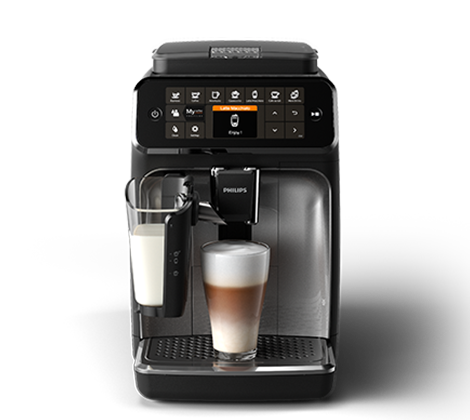#1: Philips 3200

- Easy to use
- Affordable
- Compact design
#2: Philips 4300

- More drink options
- Intuitive touchscreen
- Customizable settings
As someone who loves their daily coffee ritual, I was excited to try out both the Philips 3200 Series and the Philips 4300 Series. These two models are part of Philips' super-automatic espresso machine lineup, designed to deliver high-quality coffee beverages with minimal effort. At first glance, both machines seem quite similar, boasting features like an integrated grinder, multiple drink options, and user-friendly touch interfaces. However, after using them side by side for several weeks, I found that one of these models outshines the other in a few key ways. Here’s my in-depth, firsthand experience comparing the Philips 3200 vs. 4300.
Design and Build Quality of Philips 3200 vs. Philips 4300
unboxing both machines, I immediately noticed their sleek, compact designs. Both the Philips 3200 and 4300 have a modern, minimalist look with black plastic finishes and subtle silver accents. They’re designed to fit on most countertops without overwhelming your space, which is a big plus for someone like me who doesn’t have a sprawling kitchen.
The Philips 3200 has a slightly simpler design, which I found refreshing—it’s straightforward and easy to navigate. On the other hand, the Philips 4300 comes with a slightly more sophisticated touch panel that includes user profiles for saving preferences. While the user profiles are a nice touch, I didn’t find myself using them often since I’m the primary coffee drinker in my home.

Beverage Customization: Philips 3200 vs. Philips 4300
One of the key reasons I wanted to test these machines was to enjoy a variety of coffee drinks without needing to visit a café. Both machines offer essential beverages like espresso, coffee, and cappuccino, but here’s where they differ:
- Philips 3200 Series: This model focuses on simplicity, offering five beverage options: espresso, coffee, americano, cappuccino, and latte macchiato. It also has a "Hot Water" function, which I used for making tea.
- Philips 4300 Series: The 4300 has a slight edge in terms of drink variety, with eight options, including ristretto and flat white. While this sounds impressive, I personally didn’t find myself using the additional drinks often. For most people (myself included), the 3200’s options are more than enough.
Both machines allow you to customize strength, grind size, and milk froth levels. The Philips 3200 kept things straightforward with its intuitive interface, while the Philips 4300 required a bit more navigation through the menu to adjust settings. I preferred the simplicity of the 3200 for quick, hassle-free brewing.

Grinder and Bean Hopper Performance
Both models come with a ceramic burr grinder, which is known for its durability and ability to preserve the coffee bean’s flavor. I was able to adjust the grind settings on both machines (12 levels), which let me experiment with coffee strength and texture.
The bean hopper capacity is identical in both machines, holding 275 grams of coffee beans. However, I noticed that the Philips 3200 grinder seemed quieter than the 4300, which was important during early morning brews when I didn’t want to wake up the entire household. If noise level matters to you, the Philips 3200 is the better choice.
The Milk Frothing Systems: Key Differences
This is where I noticed one of the biggest practical differences between the two models. Both machines use Philips' LatteGo system for frothing milk, which is a standout feature in itself. It’s simple, effective, and easy to clean compared to traditional steam wands.
- Philips 3200: The milk frothing process is quick and consistent. I loved how easy it was to adjust the froth level for a cappuccino or latte macchiato. The frother delivered a creamy texture every time without requiring any effort.
- Philips 4300: While the frother is just as efficient, I found the additional customization options unnecessary for my daily routine. The 4300 lets you tweak more settings for milk texture, but honestly, the 3200’s default settings were perfect for me.
Maintenance and Cleaning
Nobody wants a coffee machine that’s a chore to clean, and thankfully, both the Philips 3200 and 4300 excel in this department. They feature removable brew groups, making it easy to rinse out leftover coffee oils. The LatteGo milk system is dishwasher-safe, which was a lifesaver for me after making milk-based drinks.
However, I found the Philips 3200 slightly easier to maintain overall. Its straightforward design means there are fewer parts to clean and fewer settings to reset. While the 4300 does have additional features like user profiles, these can complicate the cleaning process if multiple people in your household are making different drinks.

Why I Think the Philips 3200 Is Better
After weeks of daily use, I found myself gravitating towards the Philips 3200. It’s simpler, quieter, and does exactly what I need without overcomplicating things. While the Philips 4300 has a few extra features, such as additional drink options and user profiles, I didn’t feel they justified the higher price tag—especially since the coffee quality is identical between the two machines.
The Philips 3200 feels like it’s designed for people who want excellent coffee without the fuss. It’s perfect for someone like me who enjoys a cappuccino in the morning and a quick espresso in the afternoon. The controls are intuitive, and the machine consistently delivers café-quality drinks.
Use Cases: Who Should Buy the Philips 3200 vs. Philips 4300?
- Philips 3200: Ideal for individuals or small households who value simplicity and efficiency. If you’re looking for a reliable coffee machine that delivers great drinks without unnecessary extras, the Philips 3200 is the way to go.
- Philips 4300: Better suited for larger households or those who love experimenting with their coffee. If having user profiles and a broader range of drink options is important to you, the Philips 4300 might be worth the extra investment.
Final Thoughts: Which Coffee Machine Wins?
Philips 3200 vs 4300: Product Review Conclusion
Both the Philips 3200 and 4300 are excellent machines, but for my needs, the Philips 3200 is the clear winner. It strikes the perfect balance between quality, simplicity, and affordability. The coffee it produces is rich and flavorful, and the machine is a breeze to use and maintain.
While the Philips 4300 has its merits, including user profiles and a slightly wider drink selection, I found these extras unnecessary for my daily routine. If you’re someone who values ease of use and high-quality coffee without paying for features you might not use, the Philips 3200 is the better choice.
At the end of the day, both machines are fantastic, but I’d recommend the Philips 3200 to anyone looking for a reliable, hassle-free way to enjoy delicious coffee at home.
FAQ
Q: What are the main differences between the Philips 3200 and Philips 4300?
A: The main differences lie in the number of beverage options and the user profiles. The Philips 3200 offers five drinks (espresso, coffee, cappuccino, latte macchiato, and hot water), while the Philips 4300 provides eight drink options, including ristretto and flat white. Additionally, the 4300 features user profiles for saving individual preferences, which the 3200 does not have.
Q: Are the coffee quality and brewing process different between the Philips 3200 and Philips 4300?
A: No, the coffee quality and brewing process are virtually the same between the two models. Both machines come with a ceramic burr grinder and use the same brewing technology, delivering rich and flavorful coffee. The differences mainly relate to the additional features of the 4300.
Q: Is the milk frothing system different in the Philips 3200 and 4300?
A: Both machines utilize Philips' LatteGo milk frothing system, which is known for its ease of use and cleaning. The frothing process is efficient and produces high-quality foam in both models. However, the 4300 allows for more customization of froth levels, though many users find the default settings on the 3200 sufficient.
Q: How easy is it to clean the Philips 3200 and Philips 4300?
A: Both models are designed for easy maintenance. They feature removable brew groups and dishwasher-safe components, including the LatteGo milk system. The 3200 may be slightly easier to clean due to its simpler design and fewer parts.
Q: Which machine is quieter during operation?
A: The Philips 3200 tends to operate quieter than the 4300, especially during the grinding process. This can be an important factor for users who brew coffee early in the morning or prefer a quieter machine.
Q: Can both machines brew two cups of coffee at once?
A: Yes, both the Philips 3200 and 4300 can brew two cups of coffee at the same time, making them convenient for households with multiple coffee drinkers.
Q: Do I need to use filtered water with these machines?
A: While it's not mandatory, using filtered water can help reduce scaling and prolong the life of your machine. Both models feature descaling alerts, so it's important to descale regularly based on your water hardness.
Q: Are there any significant price differences between the Philips 3200 and Philips 4300?
A: Yes, the Philips 4300 is generally priced higher than the Philips 3200 due to its additional features, such as user profiles and more beverage options. However, whether the price difference is justified depends on individual preferences and usage.
Q: Which model is better for someone new to coffee machines?
A: The Philips 3200 is often recommended for beginners due to its straightforward design, user-friendly interface, and fewer features to navigate. It's an excellent choice for someone looking for a reliable, no-fuss coffee experience.
Q: Can I use pre-ground coffee with both machines?
A: Yes, both the Philips 3200 and 4300 come with a bypass doser, allowing you to use pre-ground coffee. This is particularly useful for decaf or specialty blends.
Q: Is there a noticeable difference in the size of the two machines?
A: Both machines are designed to be compact and fit well on kitchen countertops. However, their dimensions are quite similar, with only minor variations. They both have a small footprint, making them suitable for most kitchens.
